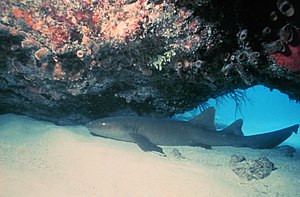Atlantic nurse shark
| Atlantic nurse shark | ||||||||||||
|---|---|---|---|---|---|---|---|---|---|---|---|---|

Atlantic nurse shark ( Ginglymostoma cirratum ) |
||||||||||||
| Systematics | ||||||||||||
|
||||||||||||
| Scientific name | ||||||||||||
| Ginglymostoma cirratum | ||||||||||||
| ( Bonnaterre , 1788) |
The Atlantic nurse shark ( Ginglymostoma cirratum ) ( ger .: atlantic nurse shark ) is a shark , which in the area of West Atlantic between Rhode Iceland and Brazil , in the eastern Atlantic between Senegal and Gabon occurs.
At birth it is approx. 27 cm long and can reach sizes up to 430 cm. The reproduction takes place as with most cartilaginous fish and all other nurse sharks ovovivipar so viviparous with a litter size of up to 28 pups.
As with all nurse sharks, nasal whiskers sit at the bottom of the rostrum , the 4th and 5th gill slits are very close to each other, the 2nd dorsal fin is clearly visible in front of the anal fin , it has furrows between the nose and mouth and the mouth is relatively small and sits clearly in front of the eyes . It is characterized by its rounded dorsal fins and long barbels. It is brown and has dark spots as an adult ( sexually mature ) animal.
The habitat includes coral reefs and mangroves and depths between 1 m and 50 m. In the daily resting phase, you can often find small groups on the floor. At night it hunts invertebrates such as B. sea urchins , lobsters , crabs , octopuses , also stingrays and bony fish . He also looks for prey hidden under coral debris , where his sensitive barbels help him, and digs up this prey.
The Atlantic nurse shark shows a pronounced territorial behavior. Experiments have shown that observed animals stay in the same area for 4 years.
literature
- Ralf Michael Hennemann: Haie & Rochen Weltweit , Hamburg 2001, IKAN-Unterwasserarchiv Frankfurt, ISBN 3-86132-584-5
Web links
- Atlantic nurse shark on Fishbase.org (English)
- Ginglymostoma cirratum inthe IUCN Red List of Threatened Species 2013.1. Posted by: Rosa, RS, Castro, ALF, Furtado, M., Monzini, J. & Grubbs, RD, 2006. Retrieved November 6, 2013.